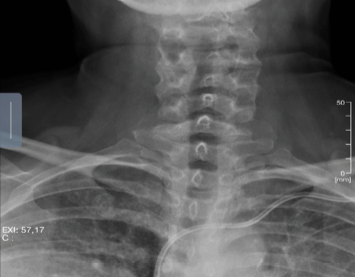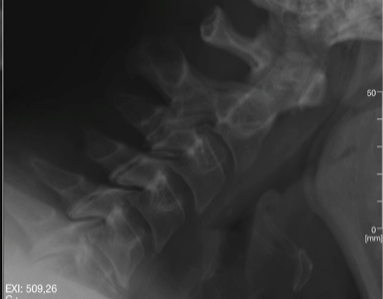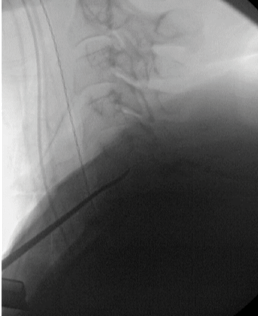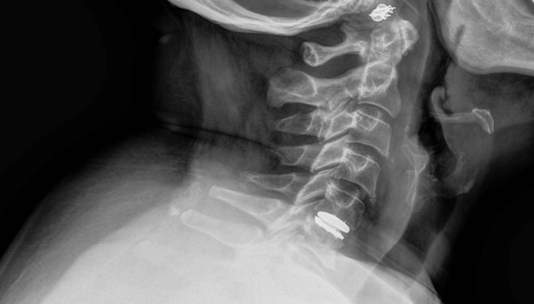CASE report
By Jose H. Jimenez-Almonte, MD, MS

Jose H. Jimenez-Almonte, MD, MS
Education:
Areas of Interest:
Minimally invasive treatments to effectively manage all aspects of complex spinal disorders. Dr. Jiménez-Almonte is one of the few dual-fellowship spine surgeons in the United States. He has completed two separate fellowships in complex spine deformity and minimally invasive/robotic spine surgery. His training makes him one of the few spine surgeons in the nation that merges complex spine surgery with the latest in micro-invasive, motion preserving, non-fusion, and outpatient surgical techniques.
51-year-old female, right hand dominant, that presented for evaluation for left sided arm pain. The patient was previously evaluated for carpal tunnel syndrome and the work-up was negative. Patient complains of left arm pain which is more significant than axial neck pain. The pain is worst with range of motion of the neck and affects her in activities of daily life such as dressing herself, cooking, and driving. The patient works as a chef.
Conservative Management
Previous conservative management included home exercise program, yoga, supervised physical therapy, anti-inflammatory medication, Medrol Dosepak, cervical epidural injection with 30% improvement for two weeks, cold compresses, warm compresses, and deep tissue massages.
Physical Examination
On physical examination the patient has pain with range of motion of the neck, worse with left rotation and left lateral bending. Patient is weak at the left C6 distribution with 4/5 strength and decreased sensation in bilateral C6 distribution.
Patient Reported Scores
Imaging Evaluation
AP lateral x-rays of the cervical spine pertinent for disc degeneration at C5-C6 with minimal facet arthrosis and spondylolysis. Adequate cervical lordosis and no signs of focal kyphosis (Figures 1 & 2).
Flexion and extension x-rays of the cervical spine with no signs of instability, retrolisthesis or anterolisthesis (Figures 3 & 4).
MRI of the cervical spine without contrast pertinent for disc degeneration at C5-C6 with no significant facet arthrosis or spondylolysis. Disc height loss as C5-C6 with significant central stenosis and bilateral foraminal stenosis (Figures 4 & 5).
Diagnosis & Treatment
51-year-old female patient, healthy and active, with cervical stenosis and radiculopathy at C5-6. The patient has failed conservative management which includes physical therapy, home exercise program, medications, activity modification, and epidural steroid injections.
Different surgical options such as anterior cervical fusion, anterior cervical disc replacement, and posterior cervical decompression were discussed with the patient. Patient was interested in motion preserving techniques due to her active lifestyle and occupation. Therefore, she decided for the cervical disc replacement for the following reasons: decrease in re-operation rate, decrease in adjacent segment disease, and motion-preserving technique.






Surgery
The patient was taken to surgery after clearance by primary care provider and anesthesia team as per our practice protocol. The surgery was uneventful without any surgical or technique complications.
The implant selection was based on the patient’s bone anatomy, preference of semi-constrained implant, and freedom of intraoperative choice of implant bone fixation to the vertebral body. As shown on intraoperative live fluoroscopy (Figure 7), the patient’s superior template appears to be more concave compared to the pre-operative x-rays. This makes the prodisc Cervical ‘Match-the-Disc’ disc replacement system the perfect option since I was able to change my implant choice interactively from a flat superior endplate to concave superior endplate with the prodisc C Vivo cervical disc replacement option. This is crucial, since Centinel Spine is the only cervical disc available that gives the surgeon the option of matching the disc replacement shape to the patient specific anatomy.
The Centinel Spine prodisc Cervical system also provides the surgeon with the option of evaluating the endplates intra-operatively after the discectomy and endplate preparation is completed, to make the right choice for endplate selection in regard to the disc replacement (flat versus concave). Also provides the option between different fixation methods such as keel fixation and keel-less fixation; and provides the surgeon the option to select according to the perceived bone quality of the patient intraoperatively.
Unfortunately, none of these options are present with other cervical disc replacement, specifically Mobi-C.
In addition, prodisc is a fixed disc arthroplasty device compared to Mobi-C which is a mobile semi-constrained device with concerns of focal hypermobility.
Post-operative Follow Up
At most recent follow up (6-months post-operatively), the patient is doing extremely well with complete resolution of radiculopathy and complete recovery of strength (Figure 8). The patient is completely satisfied with the cervical results and ecstatic regarding returning to her active lifestyle and maintaining her motion.
Take-Aways
Medicine is not only a science, it is an art; and spine surgery is not the exception. Spine surgery is the art of selecting the right procedure for the right patient. Patient specific surgery, patient driven surgery, and implant selection according to patients’ anatomy are the future in our field. No two patients are the same, and no two surgeries are the same. Centinel Spine’s Match-the-Disc cervical disc replacement system provides the surgeon with an amplitude of options to be able to serve our patients better and select the implant that most closely mimics the patient’s innates anatomy to respect the patient’s physiology.


EDUCATIONAL development
Centinel Spine offers a variety of educational programs tailored to meet the diverse training needs of physicians. Hands-on Bioskills Courses, Peer-to-Peer Webinars, and OR Surgical Observations have been designed to review patient selection, surgical technique and tips, post-operative care, and other related topics. These programs can be customized to individual physician needs, providing varied levels of support to surgeons.

About our
Hands-on Bioskills Courses
These courses provide surgeons with an educational experience focused on patient selection, surgical technique, strategies, and solutions for addressing specific spinal pathologies. The course format includes lectures, case discussions with expert faculty, and a bioskills lab.
The curriculum covers biomechanical considerations, indications and patient selection, surgical technique, tips and tricks, post-operative care, and best practices.

About our
Peer-to-Peer Webinars
Centinel Spine’s live streaming webinars provide a convenient way for physicians to learn from experts in motion preservation discussing specific treatments, techniques, and strategies for patient care.
Our interactive webinars allow participants to pose questions, receive answers, and exchange ideas in real-time with their surgeon peers from the comfort of their homes or offices.

About our
Surgical Observations
Surgical Observations are a surgical technique training and continuing education program that exposes surgeons to the technical procedures and skills required for anterior column surgery, through a combination of case discussions and viewing live surgery.
Surgeon OR Visitations are offered at Centinel Spine experienced faculty locations, where key thought leaders in spine educate with a focus on the anterior spinal column.
Watch this short primer on Centinel Spine and its unique and extraordinary place as a catalyst of change in the spine industry—with pioneering technologies and a clinical history that have led to successes ranging from PGA champions to a growing list of surgeon-patients.
Watch the Video